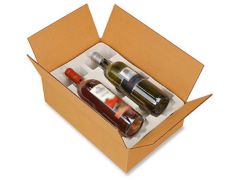Collection: Gift Style and Fun.
There's a Wine [Accessory] For That!
See All Accessories


Balance the Structures
We sense salty, sour, sweet, bitter, fat and umami with our palates. Similar components can be found in wines. Sour tastes are reflected in the acid content of wines. We can sense the acidity levels of a wine by thinking about how much it makes your mouth water. Fat or richness corresponds to the body of a wine. Does it feel like skim milk or heavy cream on your palate? Bitter sensations come from tannins. Tannins in wine also dry your mouth as the bind proteins in your saliva. We can feel the dryness in our cheeks or on our tongue or between our teeth and gums.
By recognizing the presence (or absence) of acid, body, sweetness and tannin in wine, we can start to play with the balance of these components with particular foods in the same way we pair salty-sweet together in peanut butter and jelly or bitter-fat together with tea and cream.
Match the Flavors
We can't overlook the importance of matching the aromas/flavors. Cranberry sauce doesn't just work at Thanksgiving because the tart notes cut the richness of the food, but also because red fruits make a great flavor compliment to many white meats, including turkey.
Wine aromas/flavors span every isle of the grocery store. Fruit flavors in wine range from citrus (lemon, lime, pineapple, mango, lychee) to red (raspberry, strawberry, cherry, cranberry etc) to dark (blueberry, blackberry, black plum etc), and even get further defined into underripe/tart to ripe or overripe/jammy in quality. Savory notes like dried herbs, smoked meat, and baking spice bring complexity. Supporting casts of notes of cream, vanilla and nuts, follow. Think about which flavors and aromas dominate each wine, and which foods would they be a tasty flavor match with.
Watch the Intensities
This last tip is arguably just as important as the first two combined. Wine and food pairings should enhance the taste of both the wine and the cuisine. If one dominates over the other, the pairing is off balance and pointless. Brie with Cabernet Sauvignon has a good play on structures (creamy brie being balanced by elevated tannins and acidity in the wine) and flavors (cream with rich red and dark fruit notes) but in reality this pairing is a disaster. The intensity of both the structure and flavors of a Cabernet Sauvignon are far greater than that of a mellow, somewhat muted cheese like brie. The cheese will completely loose itself in this pairing.

Soft, Tangy Cheeses
Match tang with tang. High acid wines can stand up to cheese like Chèvre (or other goat's milk cheeses) and feta. Wines with lower acidity will fall flat against these cheeses and you'll be left with an off balanced pairing.
Wines that Work: Sancerre (Sauvignon Blanc) is a classic pairing with Chèvre. Other high acid wines like sparkling wines or Chenin Blanc can work well, too. Rosés often bring enough acidity as well as berry notes can make a great flavor match to various cheese. Wines like Albariño, Assyrtiko or Muscadet have high acidity as well as underlying saline notes that can play especially well with tangy, salty cheeses like feta.
Rich, Double/Triple Cream Cheeses
Rich, creamy cheeses like triple cream brie offer two different pairing strategies. Fuller bodied wines can match the palate weight of the cheese, or higher acid wines can be used to cut through the richness. But don't forget to think about the flavors and intensity matching, too.
Wines that Work: Match the richness with higher body whites such as an oaked Chardonnay (not stainless tank), Semillon, Marsanne/Roussane or Viognier. Cut the richness with higher acidity whites: Sauvignon Blanc, Albarino, Chenin Blanc, Rosés and Sparkling Wines.
Moderately Hard Cheeses
Softer cheeses like soft, creamy cheddar, Manchego, Gouda and Harvarti bit more flavor and bite, and can handle a lighter-bodied red wine. The key will be to watch the body and tannin level, as we don't want to overwhelm the cheese.
Carbonic/Semi-carbonic reds (this production technique maximizes light, fruity freshness, while keeping tannins in check) are all the rage and pair well with many foods.
Wines that Work: Pinot Noir from California or Northern Italy works for milder cheeses, whereas Burgundy or Oregon Pinot Noir can be a good match for for earthier cheeses like Comté. Gamay, Grenache, Chianti, Rioja, Chinon, Basic Valpolicella and this carbonic Sangiovese, can all work as well.
Hard, Smoked or Aged Cheeses
The rich flavors and textures in cheeses like Parmsean, Smoked Gouda and hard, Cheddar, as well as umami notes that come from cave-aged cheeses, gives us the chance to play with bolder wines.
Wines that Work: Cabernet Sauvignon, Cabernet Franc, Sangiovese, Malbec, Valpolicella Ripasso are a handful that can work. Oak aged, Rioja Reserva or Grand Reservas can also stand up to a bold cheese like smoked cheddar, making a killer match.
Funky Stuff
Funky cheese is bold cheese. Blue Cheese, Gorganzola and Tellegio pack a flavor punch. To keep intensities balanced, you'll want to grab a bold wine. Something with body, flavor intensity and maybe even sweetness.
Wines that Work: Sweet white wines like Gewurtraminer with some residual sugar, Late harvest Riesling, Tokaji, Sauternes and Fortified Muscats can work well with bold, funky cheeses, as can sweet red wines like Ruby Port or Banyuls.

Delicate Meats
When pairing wines with meat, the fat content and flavor intensity of the meat should be considered.
Wines that Work: Just like filet minion can be easily overwhelmed with robust wines like Cabernet Sauvignon or Malbec, so can more delicate cured meats such as proscuitto or mortadella. Meats with less marbling and flavor intensity can shine when paired with slightly less intense (but still earthy enough) medium tannin wines like Pinot Noir from Oregon, Burgundy or Northern Italy, Chianti Classico or a basic Valpolicella. Carbonic reds mentioned above can also work well. And if all else fails, you can never go wrong grabbing a rosé or sparkling rosé.
Richer Meats
If you've got an itch for a heavier wine, make sure you've got some bolder flavor selections and/or higher fat content with your cured meats. Something like a sorpressata, blood sausage, chorizo, bolder flavored, Bresaola or a game meat can work well with bolder wines. Beware, however, of anything too spicy in the meats, as tannins and capsaicin are usually an unwelcome match.
Wines that Work: Syrah, such as meaty versions from the northern Rhone or more fruit forward new world bottles can both pair well. Malbec and Cabernet Franc also make a good match.

Dried Fruits and Nuts
Many white wines pair well with dried fruits and nuts.
Wines that Work: Sparklings, Arneis, Gavi, Gewurtztraminer all work well. Saline notes in Albariño and Muscadet make a nice compliment as well.
Olives, Pickles, Veggies and Herbs
Vegetables and pickles can be a wine pairing challenge. The best best is to grab wines with similar notes.
Wines that Work: Cabernet Franc and Carmenere are two red wines that contain ample pyrazines, imparting flavors of bell pepper, chilis and/or herbal notes. These wines can be a great match for cured meats on rosemary crackers or olive-laden mortadella. Many white wines also contain pyrazines or other compounds that add 'green,' or savory notes. Green notes in Sauvignon Blanc (ranging from grassy in Loire Valley wines to pickled jalepeño in New Zealand), leek notes in Grüner Veltliner, and fennel notes in wines like Spanish Verdejo make these wines a great match for veggie components and crudites.




 Add Photo &/or Message ($6.00)
Add Photo &/or Message ($6.00)
 Add Another Bottle
Add Another Bottle

 Add Photo & Message ($6.00)
Add Photo & Message ($6.00)
 Add Photo & Message ($6.00)
Add Photo & Message ($6.00)
There's a Wine [Accessory] For That!